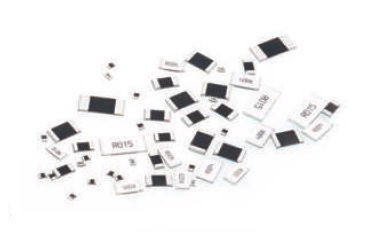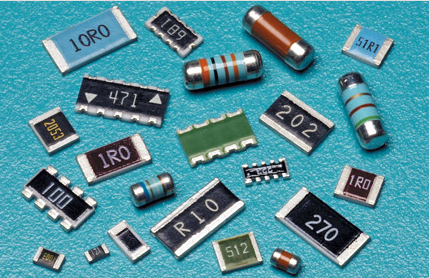Position:Home » Technical Articles
Thin and Thick Film Resistors' Characteristics and Applications
Writer:Microhm Page View:Date:2019-08-20
Thin and thick film resistors are the most common types in the market. They are characterized by a resistive layer on a ceramic base. Although their appearance might be very similar, their properties and manufacturing process are very different. The naming originates from the different layer thicknesses. Thin film has a thickness in the order of 0.1 micrometer or smaller, while thick film is around thousands time thicker. However, the main difference is method the resistive film is applied onto the substrate. Thin film resistors have a metallic film that is vacuum deposited on an insulating substrate. Thick film resistors are produced by firing a special paste onto the substrate. The paste is a mixture of glass and metal oxides. Thin film is more accurate, has a better temperature coefficient and is more stable. It therefore competes with other technologies that feature high precision, such as wirewound or bulk metal foil. On the other hand, thick film is preferred for applications where these high requirements are not critical since prices are much lower. As a professional resistor provider, Microhm provide all kinds of resistors, including thin film resistors and thick film resistors, for example NAP series, NR series and more.

Schematic view of a thin film chip resistorThe resistive layer is sputtered (vacuum deposition) onto a ceramic base. This creates a uniform metallic film of around 0.1 micrometer thick. Often an alloy of Nickel and Chromium is used (Nichrome). They are produced with different layer thicknesses to accommodate a range of resistance values. The layer is dense and uniform, which makes is suitable to trim the resistance value by a subtractive process. With photo etching or by laser trimming patterns are created to increase the resistive path and to calibrate the resistance value. The base is often alumina ceramic, silicon or glass. Usually thin film is produced as a chip or smd resistor, but the film can also be applied onto a cylindrical base with axial leads. In this case, more often the term metal film resistor is used.

Thin film is usually used for precision applications. They feature relatively high tolerances, low temperature coefficients and low noise. Also for high frequency applications thin film performs better than thick film. Inductance and capacitance are generally lower. The parasitic inductance of thin film can be higher if it is executed as a cylindrical helix (metal film resistor). This higher performance comes with a cost, which can be factors higher than the price of thick film resistors. Typical examples where thin film is used are medical equipment, audio installations, precision controls and measurement devices. Microhm thin film resistors are widely used in these fields.

Schematic view of a thin film chip resistorThe resistive layer is sputtered (vacuum deposition) onto a ceramic base. This creates a uniform metallic film of around 0.1 micrometer thick. Often an alloy of Nickel and Chromium is used (Nichrome). They are produced with different layer thicknesses to accommodate a range of resistance values. The layer is dense and uniform, which makes is suitable to trim the resistance value by a subtractive process. With photo etching or by laser trimming patterns are created to increase the resistive path and to calibrate the resistance value. The base is often alumina ceramic, silicon or glass. Usually thin film is produced as a chip or smd resistor, but the film can also be applied onto a cylindrical base with axial leads. In this case, more often the term metal film resistor is used.

Thin film is usually used for precision applications. They feature relatively high tolerances, low temperature coefficients and low noise. Also for high frequency applications thin film performs better than thick film. Inductance and capacitance are generally lower. The parasitic inductance of thin film can be higher if it is executed as a cylindrical helix (metal film resistor). This higher performance comes with a cost, which can be factors higher than the price of thick film resistors. Typical examples where thin film is used are medical equipment, audio installations, precision controls and measurement devices. Microhm thin film resistors are widely used in these fields.
Latest News
- Resistor's role in measuring and correcting LED,,,
- Single through-hole resistors' characteristics ,,,
- Why shunt resistors for current sense applicati,,,
- Metal-film resistors with small size, high resi,,,
- 36W High-Current Shunt Resistors MMS8420,,,
- 1W Surface Mount Resistor MPR1206,,,
- An Overview of Microhm Electronics' Resistor Pr,,,
- More anti-sulfur resistors used in harsh envir,,,
- Resistance changes with temperature,,,
- 140W TO247 High Power Heatsinkable Resistor,,,
- MMS5930 is ideal for current sensing in industr,,,
- Shunt resistors selection for engineers' design,,,
- Considerations for choosing precision resistors,,,
- Ceramic Encased Cement Resistors NWH Series for,,,
- Resistors for Passive Balancing in Battery-Pow,,,
Hot Articles
- Microhm will take part in 10th Automotive World,,,
- Thanks for Visiting Microhm's Booth E5-5706 in ,,,
- Resistors in Short Supply: Blame Cars,,,
- New lunch: High Power Precision Shunt Resistor,,,,
- How to Test a Resistor,,,
- Innovative Technology, Future Electric: Electri,,,
- What is Precision Resistors?,,,
- SMD Resistors Sizes and Packages,,,
- The Construction and Features of Metal Film Res,,,
- What is a TO-220 Resisor?,,,
- Hot Selling Products: Precision Shunt Resistors,,,
- How to Calculate the Equivalent Resistance Valu,,,
- What is a Fixed Resistor?,,,
- Resistors in LED Circuits,,,
- Resistors Types and Materials Overview,,,
Resistance applications
- Carbon Film Resistors' Features and Application,,,
- Urbanization Development Bringing the Transform,,,
- Difference Between High Precision Resistors and,,,
- Shunt Resistor MMS8420 for High Current Stable ,,,
- Precision Resistors' Construction and TCR,,,
- Select the Right Resistor for Harmonic Filterin,,,
- Surface Mount Resistor's Size and Package ,,,
- Heater Blower Motor Resistor in Air Conditioner,,,
- Industrial Roberts Applied to Solar Photovoltai,,,
- The Measurement Accuracy of Automotive Shunt is,,,
- The Main Application for High Precision and Low,,,
- The Four Important Functions of Alloy Resistors,,,
- Why Zero-Ohm Resistors?,,,
- BMS for New Energy Vehicle,,,
- Miniature future for passive electronic compone,,,
